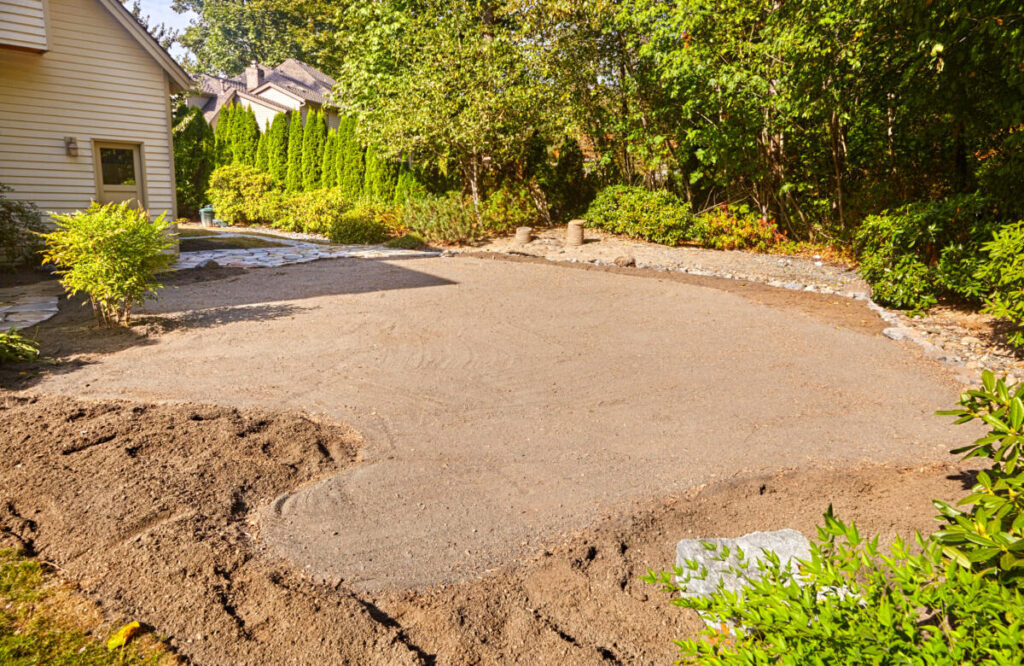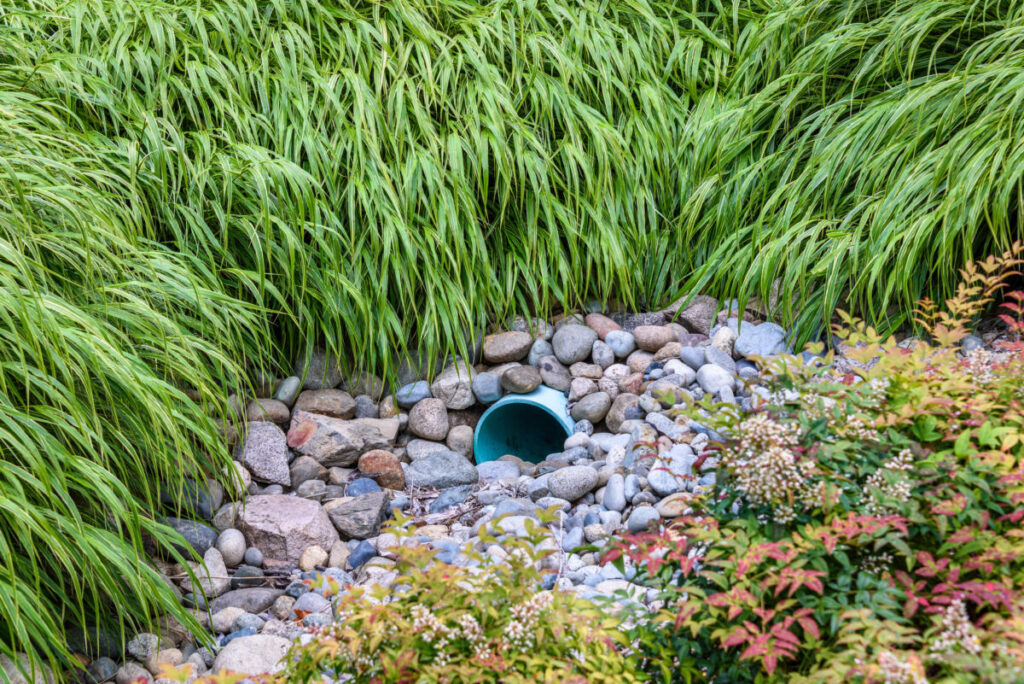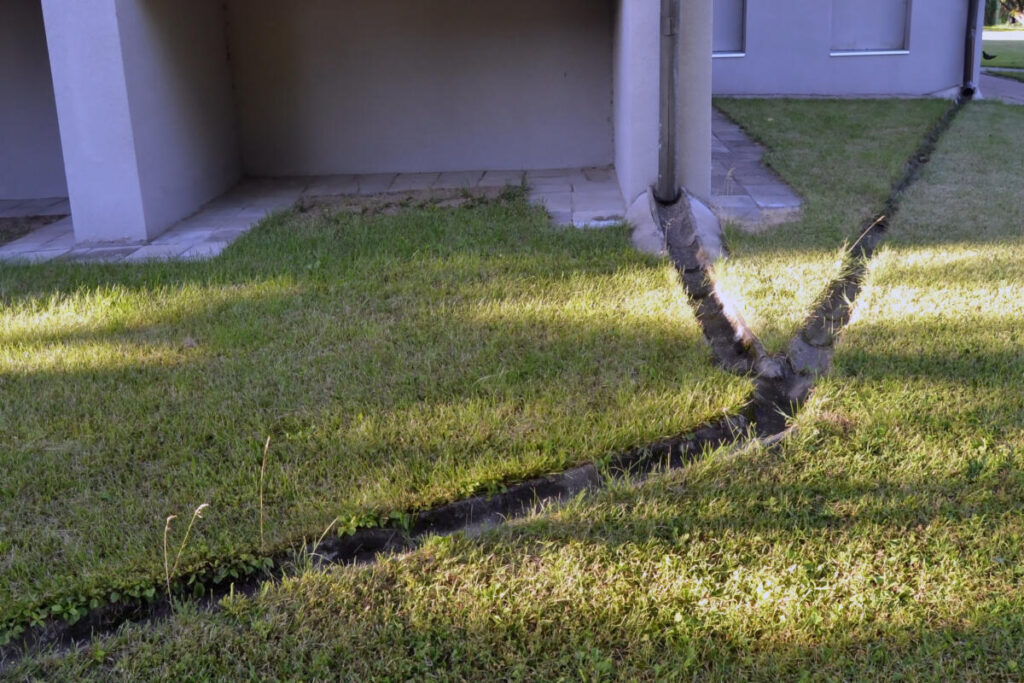If you’ve ever experienced soggy lawns, standing water, or water seeping into your basement, you know the importance of proper landscape drainage. But how can you protect your home’s foundation and ensure a healthy, beautiful yard? In this comprehensive guide, we’ll walk you through eight critical considerations for effective DIY yard drainage solutions.
Short Summary
- Identify landscape drainage issues and assess the yard’s slope to ensure proper drainage.
- Install a French drain or use rain gardens & dry creek beds for effective water management.
- Utilize catch basins, pipes & storm drains. Aerate soil & modify hardscapes with permeable materials as needed. Hire a professional if necessary.
1. Identify Landscape Drainage Issues
Before you can address a yard drainage issue, you must first identify it. Signs of poor yard drainage may include standing water, soggy soil, and unhealthy plants.
By recognizing these issues, you can take the necessary steps to mitigate potential consequences, such as foundation damage and plant mortality.
Signs of Poor Yard Drainage
The presence of standing water in your yard is a clear indication of a drainage problem, as it shows that water is not draining efficiently and is accumulating in certain areas. Soggy soil is another sign of poor yard drainage, as it implies that water is not draining as it should and is instead saturating the soil.
Unhealthy plants can also indicate drainage issues, as compacted soil underneath them may not drain properly, depriving the plants of necessary nutrients.
Potential Consequences
Inadequate drainage in your yard can lead to serious consequences, such as foundation damage, plant mortality, and mosquito proliferation. Addressing these issues promptly is essential to prevent increasingly severe problems for the property, such as the need for installing a drainage pipe or other drainage solutions.

2. Grade Your Landscape for Proper Drainage
Grading your landscape is an important step in ensuring proper drainage. By assessing your yard’s slope and using regrading techniques, you can create a gentle slope away from your home to help manage excess water and protect your home’s foundation.
This slope should be gradual, with no more than a 6-inch drop over a 10-inch drop.
Assessing Your Yard’s Slope
To determine if your yard is properly graded, it is recommended that there be a 6-inch slope over the initial 10 feet surrounding the foundation, with an additional foot of slope over the next 100 feet. It is suggested to have a 2 to 3 inches slope within 10 feet of your home. This will help prevent water infiltration into the home.
Ensuring that the top of the slope is at least 4 inches from the bottom of the siding will help protect your home’s foundation.
Regrading Techniques
Regrading techniques can help create a slope that directs water away from your home and prevents pooling. Suitable techniques include:
- Identifying the high and low spots in the yard and reversing them
- Using the back of a rake to create a smooth and even grade
- Aiming for a slope of 2% to 5% for proper drainage
Measuring the existing grade and adjusting it by moving dirt to make it steeper or change its direction is also important.
3. Install A French Drain If Appropriate
Installing a French drain can be an effective solution if other drainage methods are insufficient. A French drain is a trench filled with gravel and a perforated pipe that redirects water away from an area, thus preventing water accumulation and its associated damage.
It can be especially beneficial for diverting water away from your home’s foundation.
Benefits of a French Drain
A French drain offers numerous advantages, including:
- Preventing flooding and mitigating the risk of water damage to your property
- Diverting surface water to maintain a dry lawn
- Providing a straightforward pathway for water to flow through
- Helping to keep the crawl space beneath a home dry
These advantages include preventing flooding, mitigating the risk of water damage, and diverting surface water.
Choosing the Right Location
When selecting a location for a French drain, it is important to consider factors such as:
- problem areas
- nearby elevation
- slope
- water pooling
- soil condition
Identifying areas where water tends to accumulate or where water drainage is inadequate can help you choose the most effective location for your French drain.
The location of the French drain should be chosen carefully to ensure that it is able to effectively divert.
4. Rain Gardens and Dry Creek Beds
Rain gardens and dry creek beds are landscaped depressions planted with native plants that capture, temporarily hold, and filter stormwater back into the ground. These features are designed to help manage and reduce stormwater runoff, thus preventing erosion and pollution of water sources.
By creating rain gardens and dry creek beds, you can not only manage excess water but also add visual interest to your landscape.
Designing a Rain Garden
When designing a rain garden, it is important to follow these steps:
- Sketch a design prior to commencing excavation.
- Choose a natural, rounded shape, such as an oval, teardrop, or kidney shape, for your rain garden.
- Find the most suitable place for a rain garden, which is usually in a low-lying area of the yard where water accumulates naturally.
Constructing swales or channels to direct runoff from gutters and higher parts of the yard into the rain garden can facilitate the flow of runoff into the garden.
Creating a Dry Creek Bed
To create a dry creek bed, follow these steps:
- Determine the layout based on the slope of the land and the direction of water flow.
- Excavate a trench along the desired path of the creek bed.
- Lay down a pipe that will direct the water away from the house. The pipe should be connected to a catch basin or other drainage system.
- Fill the trench with gravel, ensuring that the pipe is covered.
- Cover the gravel with soil, creating a natural-looking creek bed.
Adding plants to the edges of the creek bed, such as ornamental grasses or native shrubs, can further enhance its natural appearance.
5. Catch Basins and Drain Pipes
Installing catch basins and drain pipes can help manage excess water and prevent damage to your home and landscape. A catch basin is a large vessel constructed from polypropylene or masonry, mostly buried underground with a grate at ground level for water drainage.
Drain pipes connect to catch basins and direct water away from the home, preventing water accumulation and damage.

Installing a Catch Basin
To install a catch basin, begin by excavating a hole in the ground that is slightly larger than the basin itself. Place the basin in the hole and fill it with gravel or sand.
Next, connect the catch basin to a drain pipe and secure it with clamps. The catch basin will collect the water and direct it away from your home through the drain pipe.
Selecting the Right Drain Pipe
When selecting a drain pipe, factors such as size, material, and slope should be taken into consideration. The size of the pipe required for your landscape drainage requirements will depend on the quantity of water that needs to be drained and the size of the area that needs to be drained. Popular materials used for drain pipes include PVC, ABS, and cast iron.
The slope of the pipe should be determined based on the required drainage capacity and the size of the area to be drained, ensuring that the slope is neither too steep nor too shallow.
6. Storm Drains and Yard Drains
Maintaining storm drains and installing yard drains can help manage excess water and protect your home and landscape. A storm drain is a system designed to collect and convey rainwater or runoff from streets, driveways, and other hard surfaces.
Yard drains can be installed to help direct excess water away from your home and prevent damage to your landscape.
Maintaining Storm Drains
To ensure proper functioning of storm drains, the following steps should be taken:
- Routine cleaning of debris, leaves, and other materials that could cause clogging is essential.
- Regular inspections should be conducted to detect any signs of damage or deterioration.
- If any damage is identified, prompt repair is necessary.
Installing Yard Drains
When installing yard drains, follow these steps:
- Begin by digging a trench.
- Lay down a pipe that will direct the water away from the house.
- Connect the pipe to a catch basin or other drainage system.
- Fill the trench with gravel.
- Cover the trench with soil.
Yard drains can help direct excess water away from your home and prevent damage to your landscape.
7. Aeration and Soil Improvement
Improving your landscape’s drainage can also be achieved by aerating your lawn and enhancing your soil’s drainage capabilities. By using lawn aeration techniques and incorporating organic matter into your soil, you can improve water absorption and promote a healthy yard.
Lawn Aeration Techniques
Lawn aeration involves creating small holes in the soil to facilitate air, water, and nutrient absorption to the grass roots, which helps to enhance the health and growth of the lawn. Two primary lawn aeration techniques are core aeration and spike aeration.
Core aeration involves extracting small plugs of soil from the lawn, while spike aeration involves using a tool to puncture the soil.
Enhancing Soil Drainage Capability
To improve soil drainage capability, increase the diversity of plants aboveground, add organic matter to improve soil structure, and incorporate organic mulch around plants to reduce surface runoff. Incorporating organic matter can enhance soil structure by increasing its capacity to retain air and water, as well as providing essential nutrients for plants.
Organic mulch assists in mitigating surface runoff by slowing the rate of water infiltration into the soil, thus enabling more water to be absorbed by the soil.
8. Hardscape Modifications
Modifying your hardscape can also help improve landscape drainage. By using permeable paving options and replacing non-permeable materials, you can allow water to pass through and reduce runoff. This can help protect your home’s foundation and keep your yard healthy and beautiful.
Permeable Paving Options
Permeable paving options, such as pervious concrete, porous asphalt, and permeable interlocking concrete pavers, allow water to permeate and diminish runoff, contributing to the development of sustainable landscapes. These materials are advantageous for creating sustainable landscapes, as they allow water to infiltrate through the surface, avoiding the formation of puddles and promoting sustainability.
By using permeable paving materials, water is able to be absorbed into the ground, reducing the amount of water in the ground.
Tips for Hardscape Replacement
When replacing non-permeable hardscape materials, consider using crushed gravel or pea gravel to facilitate even drainage. Other permeable hardscape materials include permeable pavers and grass pavers, which can also help improve landscape drainage by allowing water to pass through and reduce runoff. If you’re considering this approach, it’s probably best to talk with a professional hardscaping company to make sure you’re on the right path.

When to Hire a Professional
If you are unsure of your DIY capabilities or need expert advice for your landscape drainage project, it may be best to hire a professional. A qualified landscape drainage expert can help you assess your yard drainage problems and recommend the most effective yard drainage solutions to protect your home and landscape.
Assessing Your DIY Capabilities
Before embarking on a DIY landscape drainage project, it’s important to honestly assess your capabilities. Consider whether you have:
- the necessary tools
- equipment
- skills
- knowledge
- time
- resources
To complete the project. Also, consider any safety concerns or legal requirements that may necessitate the involvement of a professional. If you’re committed to taking the DIY approach, make sure to take a look at our DIY landscaping guide to help you get started.
Finding a Qualified Landscape Drainage Expert
To find a qualified landscaping expert, research local professionals and ask for recommendations from friends and neighbors who have had landscape drainage work completed or who have employed a landscape drainage specialist in the past.
This can help ensure that you find a reputable professional who can help you effectively address your landscape drainage needs.
The Best Way to Handle Landscape Drainage
In conclusion, effective landscape drainage is crucial for protecting your home’s foundation and maintaining a healthy, beautiful yard. By identifying drainage issues, grading your landscape, installing French drains and other drainage solutions, creating rain gardens and dry creek beds, maintaining storm drains, aerating your lawn, improving soil drainage, and modifying your hardscape, you can effectively manage excess water and prevent damage to your home and landscape. When in doubt, consult a qualified landscape drainage expert to ensure the best solution for your specific needs.
Frequently Asked Questions
Can you fix yard drainage issues on your own?
Yard drainage can be done yourself with a few common solutions, such as installing a curtain drain, digging a dry well, replacing hardscaping, and using a rain barrel. Taking the initiative to research DIY yard drainage solutions will ensure your yard remains healthy for years to come.
Who should I call for yard drainage problems?
For drainage problems in your yard, consider calling a landscape drainage professional. They have the expertise and knowledge to address any type of issue you may be facing.
What are some signs of poor yard drainage?
Signs of poor yard drainage include standing water, soggy soil, and unhealthy plants. These can be indicators that your yard isn’t draining properly.
What is a French drain and how can it help with yard drainage?
A French drain is a trench filled with gravel and a perforated pipe that redirects water away from an area, providing effective yard drainage and preventing damage to your home’s foundation. This type of drainage system is an effective way to keep your home and yard safe from water damage. It can be installed quickly and easily, and it requires minimal maintenance. With a French drain, you can be sure that your home and yard are protected from water damage.


